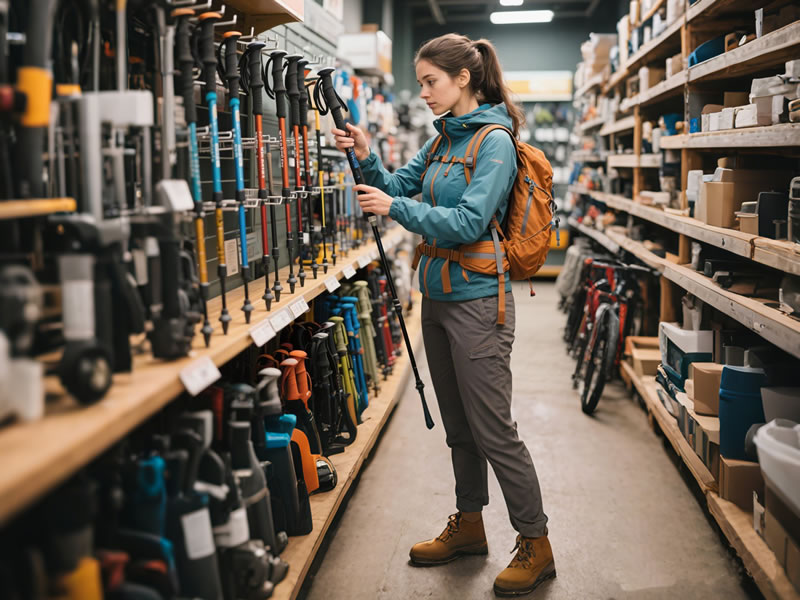What should I look for when buying trekking poles for hiking?
Trekking poles can significantly improve your hiking experience—but only if you choose the right pair. With so many options available, it’s easy to feel overwhelmed. This guide breaks down the key factors to consider when buying trekking poles, helping you find the perfect match for your hiking style, budget, and terrain.

1. Material: Aluminum vs. Carbon Fiber
Aluminum Poles
✔ Durable – Bend instead of breaking under stress
✔ Affordable – Great for beginners
✔ Reliable in cold weather – Won’t become brittle
Best for: Rough terrain, backpackers, budget-conscious hikers
Carbon Fiber Poles
✔ Lightweight – Reduces arm fatigue on long hikes
✔ Vibration-dampening – Smoother feel on rocky trails
✔ Stiffer & more efficient – Better energy transfer
Best for: Ultralight hikers, fast-paced trekkers, those with joint concerns
2. Adjustability: Fixed vs. Telescopic vs. Folding
Telescopic (Adjustable) Poles
✔ Customizable length – Ideal for varied terrain (shorten uphill, lengthen downhill)
✔ Sturdy – Flip-lock mechanisms provide secure adjustments
✔ Versatile – One pair works for different users
Folding (Z-Pole) Design
✔ Compact – Easy to pack in a backpack
✔ Quick setup – No length adjustments needed
✔ Lightweight – Preferred by thru-hikers
Fixed-Length Poles
✔ Simple & reliable – No moving parts to fail
✔ Lightest option – Used by trail runners
✔ Less adjustability – Best for specific users
3. Grip Material: Comfort Matters
Cork Grips
✔ Mold to your hands over time
✔ Wick away sweat – Great for hot weather
✔ Reduce vibration – Comfortable on long hikes
Foam Grips
✔ Soft & cushioned – Best for shock absorption
✔ Lightweight – Common in ultralight poles
✔ Can get slippery when wet
Rubber Grips
✔ Good for cold weather – Insulate hands
✔ Durable – Long-lasting
✔ Less breathable – Can cause sweaty palms
4. Locking Mechanism: Flip-Lock vs. Twist-Lock
Flip-Lock (Lever Lock)
✔ More secure – Less likely to slip
✔ Easier to adjust with gloves on
✔ Bulkier but more reliable
Twist-Lock
✔ Sleek design – Fewer protruding parts
✔ Can loosen over time – Requires occasional tightening
✔ Harder to adjust in cold weather
5. Additional Features to Consider
✔ Shock absorption – Reduces joint impact (best for downhill hikes)
✔ Interchangeable tips – Carbide for rocks, rubber for pavement
✔ Baskets – Snow baskets for winter, small baskets for summer
✔ Wrist straps – Should be padded & adjustable for comfort
Final Buying Tips
- Test before buying – Check grip comfort and adjustability
- Match poles to your hiking style – Backpacking? Go durable. Trail running? Go lightweight.
- Consider weight – Lighter poles reduce fatigue but may cost more
- Read reviews – Real-user feedback helps avoid poor-quality models
FAQ
Q: Should I buy one or two trekking poles?
A: Two poles provide better balance and joint protection.
Q: How tall should trekking poles be?
A: At 90° elbow bend when standing on flat ground.
Q: Are expensive trekking poles worth it?
A: For casual hikers, mid-range works. For serious trekkers, invest in quality.
Conclusion
The best trekking poles depend on your hiking style, budget, and terrain. Whether you prioritize durability, weight, or comfort, this guide helps you make an informed choice.
Ready to hit the trails? Grab your perfect pair and hike stronger, longer, and with less fatigue! 🚶♂️
#HikingGear #TrekkingPoles #HikingTips #OutdoorAdventure






